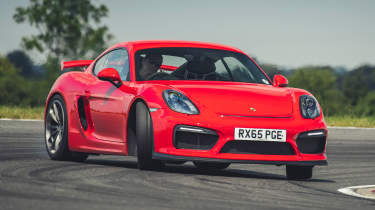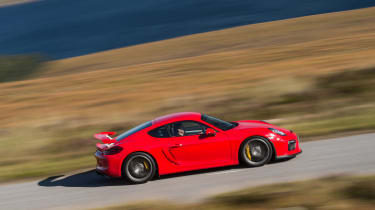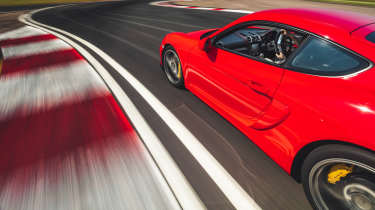Used Porsche Cayman GT4 (981, 2015 – 2016): review, price and specs of a sports car great
The Porsche Cayman GT4 answered ten years of cries for a proper Porsche Motorsport-prepared version of the marque’s junior sports car in spectacular style
The Cayman GT4 marked the first time Porsche’s GT department had laid its hands on the Cayman, and the results were just as stunning as we had always hoped they might be. It emerged victorious from eCoty 2015 on Scotland’s challenging North Coast 500, even though it was in a group that also included the wild Lamborghini Aventador SV, blistering McLaren 675LT and Porsche’s own 911 GT3 RS in 991.1 form.
Yes, its gear ratios might be a little long (slightly improved in its 718-generation successor), but the razor-sharp responses of the naturally aspirated 3.8-litre flat-six, the weighting of the controls and the just-so chassis balance quickly push this concern to the background. Where other performance cars can seem obsessed with achieving mind-boggling numbers at the expense of driver enjoyment, the GT4 doesn’t fall into this trap.
Porsche Cayman GT4 in detail
The Cayman’s technical constitution was a deftly-handled one. On the one hand, it didn’t step on the toes (too much) of the 991 GT3, which kept its howling 9000rpm Porsche Motorsport flat-six. But at the same time, the GT4 was no stickered-up rebadge with a wing, either, with a properly overhauled chassis.
The Cayman GT4 borrowed the 991 911 Carrera S’s 3.8-litre Powerkit engine, which gives the car plenty of straight-line performance. Low-down torque is strong and with the redline set at 7800rpm it has good top-end reach, too. Being a highly-tuned, normally-aspirated engine, throttle response is razor sharp, which means you can precisely manipulate the rear axle under power.
More reviews
In-depth reviews
Reviews
> BMW M3 CSL v Nissan R34 Skyline GT-R v TVR Sagaris v 981 Porsche Cayman GT4
The six-speed manual gearbox is one of the best around. The shift action is so sweet you change gears just for the tactile joy of it. It’s just a shame that the standard 981’s overlong gear ratios remained, meaning you rarely need to leave third gear most of the time. The extra torque of the 3.8 does disguise the problem to some degree, but with shorter ratios the engine would feel punchier still, and you could enjoy the gearshift more often.
Indeed the aftermarket has answered calls for shorter ratios in this transmission, though it requires quite the financial commitment. Our preference, too, would be for a dedicated button to make the automatic throttle blip independently switchable, to allow it to be turned off in Sport mode.
A big technical change for the Cayman GT4 over the standard 981 family was in the front suspension, where it inherited the split wishbones and larger wheel bearings of a type seen initially on the 991 911 GT3. This allowed individual manual adjustment of the car’s geometry to tune the car’s front axle for road or circuit use.
On the inside, a half cage was optional, as were the carbon bucket seats also seen in the 991 GT3s at the time, as well as the 918 Spyder hypercar.
> Porsche 718 Cayman GT4 RS review: the ultimate mid-engined sports car?
One of the signature dynamic traits of any Cayman is the impression it gives in cornering of leaning on both the front and rear axles equally hard. That means there’s no sense of the car understeering heavily or of the rear end trying to break free. With both axles digging into the road surface you feel as though you’re sat right at the pivot point of the chassis. That means you’re wonderfully in tune with the car, knowing instinctively how hard you can work the tyres.
Fitted with the 911 GT3’s heavily uprated front axle the Cayman GT4 is a boon. Whereas a GTS car can feel a touch vague, particularly in transient conditions, with remote steering and an unclear picture of where the limit of front axle grip is, the GT4 is completely intuitive. Its steering is so much sharper and more communicative, wheel writhing in your hands rather than being lifeless.
There is a trace of understeer on initial turn-in – it’s built into the chassis rather than being a shortfall of grip – but there’s so much agility and adjustability in the chassis that you can trim it out by trail-braking, or otherwise ride it out for a fraction of a second until you reach the apex, then neutralise the car on the throttle. That level of engagement is what driving enthusiasts live for.
Of course, the GT4 is a stiffer-sprung car than the standard 981s on which it was based, which gives it even tauter body control and roll resistance, but in proper Porsche Motorsport tradition, it also rides a bumpy road surface with abundant damping quality. The body is never skipped around or upset by lumps and bumps and never does the chassis run out of suspension travel in compressions.
> BMW M2 CS v Porsche 718 Cayman GT4
The limited-slip differential works with the sticky Michelin Cup 2 tyres GT4s first shipped with, to find massive traction at corner exit. When you consciously overload the driven wheels, the diff then gives a very clean and predictable breakaway, which helps to make the car even more playful.
The 981 Cayman GT4 was certainly one of the most technically capable performance car chassis at any price point when new, but the Cayman GT4 was also enormous fun to drive down a winding stretch of road. Still is, on both counts.
Porsche Cayman GT4 (981): eCoty 2015 winner
‘Here are the reasons why the Cayman is placed either first or second by every eCoty 2015 judge. Just sublime. And at no point in the test did I feel like a better driver than when I was driving the GT4,’ explains Nick before hastily retrieving his credit card from behind the bar and calling last orders. Marino, like Nick, places the GT4 second behind the McLaren, but was no less impressed by the Cayman: ‘It probably made me smile more than any other car here and it gave me thrills at all speeds.’
‘Jethro, another who put it behind the 675, is equally gushing with praise: ‘Physical, exciting, beautifully balanced, shot-through with class and control, the GT4 is everything you could ever hope a Motorsport-department Cayman to be. It’s perhaps the most involving car here.’ It’s second for Dan, too, who adds: ‘The Cayman has a really small window of understeer – more like a porthole – on initial turn-in, but you can so readily neutralise that on the throttle. That’s just one of the many ways in which it’s so engaging and responsive down a road. I don’t think I’d ever need more sports car than this.’
‘As for those of us who put the GT4 top, Goodwin says: ‘Almost perfect seating position, pedal weights and positioning. The gearshift is excellent and the GT4’s extra power makes the Cayman’s annoying gear ratios less of a problem.’ Dickie goes further, saying: ‘That steely precision and control so characteristic of Preuninger-era Porsche puts it way above any previous Cayman, but the way it feels alive and entertaining at all times means it gives you more, more of the time. It can’t live with the GT3 RS or 675LT for sheer pace, but it’s this greater accessibility and generosity that means it just nicks it for me.’
‘Adam Towler is no less forthcoming: ‘Every so often, a car comes along that feels intrinsically right. The GT4 is one such car. It’s inspiring to drive – that much is obvious in the first 250 metres. It’s the car here that best fits what I think an evo car should be like.’
‘Me? I think it’s simply brilliant. It gave me the best drive of the year, of the last decade and possibly of my life. No, really, it’s that good. Why? Because while the RS, LT, GTB and SV thrill and excite in their unique ways, it is the performance of their engines that ultimately dominates and dictates proceedings, be it the ferocious turbocharged thrust of the McLaren or Ferrari, the feral roar of the Lambo’s V12 or the thoroughbred howl of the RS’s flat-six.
‘However, in the Cayman GT4, any straight-line performance disadvantage is negligible. Its GT3-lite chassis is so adjustable, forgiving and precise that it doesn’t so much enter a corner tailing the bigger boys as edge its splitter out an inch or two, looking for a way past at every opportunity. You really need to be on your game in the more powerful cars to shake the less expensive car off, but you never feel you’re overstretching yourself in the GT4. No matter who stepped out of the GT4, the opinion was the same: Porsche has created a masterpiece. – Stuart Gallagher, eCoty 2015, evo 216
Porsche Cayman GT4 (981): price, rivals and buying guide
Not only is it an outstanding driver’s machine, it’s reliable too – if it’s been well maintained and cared for. Given it has a manual gearbox and is a prime candidate for track use, checking for over-rev reports is wise, as is looking for the usual brake, bearing and bush wear associated with hard circuit driving.
Some cars were recalled due to a gearbox fault, so ensure this has been actioned if it was affected. Dampers, catalysts and dynamic engine mounts have been known to fail, and in rare instances, strut towers have had catastrophic failures – this wouldn’t be easy to hide, but check for below-par repair work to be on the safe side.
When it launched in 2016, the Cayman GT4 started at £64,451, but that was completely academic, frankly, since Porsche sold every example it intended to make. As a result, anyone who wanted to get hold of a GT4 had to spend significantly more than that. GT4 silly season saw nearly new examples rising to over £100,000 at its peak.
Today, the market clearly still understands just how great the original Cayman GT4 is, although thankfully prices have settled a decade on from the madness of its launch. All these years later, used prices are hovering back around the £60,000 mark. In the context of new-car prices in 2025, where a Cupra Ateca is a £50,000-plus car after some options, the GT4 seems reasonably priced for what is one of the finest driver’s cars of the last decade.
Browse the classifieds and you’ll find little difference in price between the best and worst examples. At the bottom of the market, you’ll see 40,000-mile cars from £56,000, but add £4000 and examples with half the mileage come within reach. Only if you’re seeking a car in nearly new condition with a four-figure mileage will you need to stretch towards £70,000.
Rivals? Porsche’s own 991 GT3 is in the right range, if a little above, price wise, though you won’t be getting a later 991.2 manual for 981 GT4 money. Closer to home, the Lotus Evora 400 was hugely talented – on flowing along British B-roads perhaps better even than the GT4 – and can be had for less than £50k. The even better Evora 410s are closer to 981 GT4 money. Both lack the Cayman’s sense of integrity, however.
Porsche Cayman GT4 specs
| Engine | Flat-six, 3800cc |
|---|---|
| Power | 380bhp @ 7400rpm |
| Torque | 310lb ft @ 4750-6000rpm |
| Weight | 1340kg |
| Power-to-weight | 288bhp/ton |
| 0-62mph | 4.4sec |
| Top speed | 183mph |
| Price new | £64,451 (2015) |
| Value today | From £56k |










